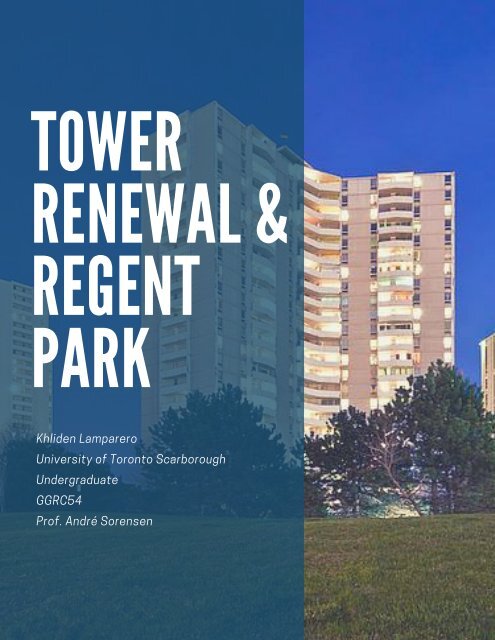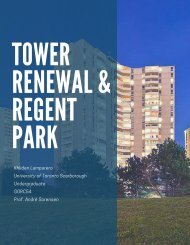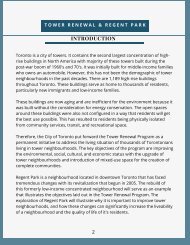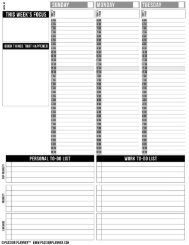merged2
Create successful ePaper yourself
Turn your PDF publications into a flip-book with our unique Google optimized e-Paper software.
TOWER<br />
& RENEWAL<br />
REGENT<br />
Khliden Lamparero<br />
PARK<br />
University of Toronto Scarborough<br />
Undergraduate<br />
GGRC54<br />
Prof. André Sorensen
T O W E R R E N E W A L & R E G E N T P A R K<br />
INTRODUCTION<br />
Toronto is a city of towers. It contains the second largest concentration of highrise<br />
buildings in North America with majority of these towers built during the<br />
post-war boom of 1960's and 70's. It was initially built for middle-income families<br />
who owns an automobile. However, this has not been the demographic of tower<br />
neighbourhoods in the past decades. There are 1,189 high-rise buildings<br />
throughout Toronto. These buildings serve as home to thousands of residents,<br />
particularly new immigrants and low-income families.<br />
These buildings are now aging and are inefficient for the environment because it<br />
was built without the consideration for energy conservation. The open spaces<br />
around these buildings were also not configured in a way that residents will get<br />
the best use possible. This has resulted to residents being physically isolated<br />
from community services, transit, and recreational space.<br />
Therefore, the City of Toronto put forward the Tower Renewal Program as a<br />
permanent initiative to address the living situation of thousands of Torontonians<br />
living in tower neighbourhoods. The key objectives of the program are improving<br />
the environmental, social, cultural, and economic status with the upgrade of<br />
tower neighbourhoods and introduction of mixed-use space for the creation of<br />
complete communities.<br />
Regent Park is a neighbourhood located in downtown Toronto that has faced<br />
tremendous changes with its revitalization that begun in 2005. The rebuild of<br />
this formerly low-income concentrated neighbourhood will serve as an example<br />
that illustrates the objectives laid out in the Tower Renewal Program. The<br />
exploration of Regent Park will illustrate why it is important to improve tower<br />
neighbourhoods, and how these changes can significantly increase the liveability<br />
of a neighbourhood and the quality of life of it's residents.<br />
2
O W E R R E N E W A L :<br />
T<br />
A I N O B J E C T I V E S<br />
M<br />
For an arrival city like Toronto, which serves as home to thousands of<br />
immigrants seeking a better life, the Tower Renewal Program is an important<br />
key to the city's liveability. There are over 500,000 people living in Toronto's<br />
older high-rise buildings, where 43% of it's residents are low-income families,<br />
and 25% are newcomers. Therefore, making improvements to this fundamental<br />
housing in the city requires a comprehensive plan of not only upgrading and<br />
retrofitting the tower buildings, but also enhancing the neighbourhood around<br />
it through the improvement of open space, and increasing the availability and<br />
accessibility of amenities and community services. This will not only improve<br />
resident's experience of their neighbourhood, but will also promote social<br />
cohesion and community development.<br />
Tower Renewal has 3 interlocking objectives:<br />
1. Environmental - a cleaner and greener city<br />
2. Social and cultural - Increased social and cultural benefits and stronger<br />
communities<br />
3. Economic - Improved local economic activity<br />
Environmental: a cleaner and healthier environment<br />
High-rise buildings consume high levels of energy per square metre. Combine this with the<br />
energy inefficient construction of the buildings, this then poses environmental issues such<br />
as rising utility costs and greenhouse gas emissions. These towers are now facing the end<br />
of it's life cycle, and are in dire need of upgrades.<br />
The Tower Renewal aims to reduce energy use through upgrades in the building. This<br />
includes exterior cladding, replacing windows and balcony doors with double pane<br />
windows and doors, updating heating and lighting systems, and more. These retrofits will<br />
not only lower operating costs, but will also reduce our environmental footprint.<br />
Findings based on Tower Renewal pilot sites shows that building upgrades results to more<br />
than 50% of energy savings, more than 20% of water savings, an increase in waste<br />
diversion of 30%, and an overall reduction in greenhouse gas emission of up to 5%.<br />
3
Social and Cultural: increased social and cultural benefits and<br />
stronger communities<br />
One of the biggest disadvantage residents in tower neighbourhoods experience is not<br />
something within their apartment buildings, but outside of it. This is accessibility.<br />
There are 2 types of accessibility issues in Toronto's tower neighbourhoods:<br />
1. Lack of accessible amenities and community services, such as childcare, grocery<br />
stores, greenspace, doctor's offices, restaurants, retail shops, etc.<br />
2. Compromised accessibility to transit. The current design of tower neighbourhoods<br />
limit people's mobility. It is surrounded by parking lots, fences that block shortcuts,<br />
sidewalks that suddenly end, and long indirect walkways that are often unpaved and<br />
turn muddy during rainy days.<br />
it is not surprising that accessibility to services is an issue in tower neighbourhoods.<br />
This is because most of the tower neighbourhoods are located in the City's 13 priority<br />
neighbourhoods. These neighbourhoods have been identified as being underserved<br />
by the City's services and amenities. The lack of accessibility to these services have<br />
significant implications to people's quality of life.<br />
According to the City's apartment neighbourhood zoning bylaw, only dwelling is<br />
allowed in tower neighbourhoods, and all other land use is deemed illegal. This<br />
includes drug stores, bank, clothing stores, coffee shops, place of worship, and etc.<br />
Fortunately, Tower Renewal has a key initiative that directly solves the issue of<br />
accessibility. This is done through the implementation of mixed-land use within tower<br />
neighbourhoods, called the Residential Apartment Commercial (RAC) zoning. This will be<br />
further discussed under the Tower Renewal: Implementation Programs section. But<br />
this zoning bylaw is key to the creation of complete communities.<br />
Economic: improved local economy activity<br />
Tower Renewal retrofitting projects will have important economic implications with<br />
the creation of significant number of jobs in the construction and building industry. It<br />
will also foster development of local businesses with the implementation of RAC<br />
zoning, which will permit a number of small scale commercial and community uses on<br />
apartment building sites. This also means that residents, particularly single parents,<br />
can have the option of acquiring employment near their place of dwelling, and will not<br />
have to travel far distances and spend so much time in transit. Instead, they will have<br />
more opportunities to be with their family. The improvement in local economic<br />
activity will contribute to the vibrancy of tower neighbourhoods, and the increased<br />
quality of life of its residents.<br />
4








